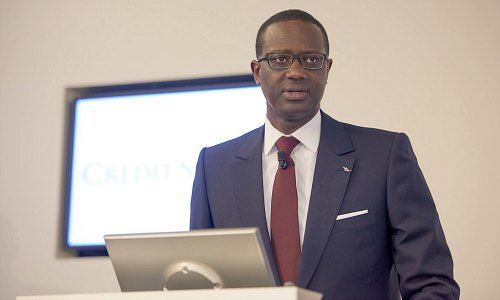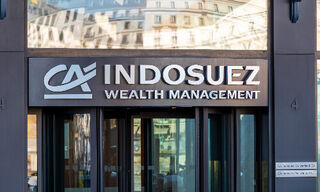Credit Suisse: More «Boom» Than «Doom»
Tidjane Thiam has put his stamp on Credit Suisse after his first full year running the bank. The strategy is beginning to take hold, is his message. finews.asia looks behind the Swiss bank's massive construction.
1. Cost Cuts: Credit Suisse's New Strategy
One of the few areas where the Swiss bank managed to beat expectations in a deeply unprofitable quarter: Credit Suisse slashed spending by 1.9 billion Swiss francs by year-end, compared to a 1.4 billion franc target. This puts the bank within striking distance of a 17 billion goal by next year.
The success is becoming part of Credit Suisse's strategy: CEO Tidjane Thiam walked back various profit targets in December. He also promised to cut another 1 billion francs, which was lauded by investors.
Credit Suisse cannot shrink itself into growth – an issue that domestic rival UBS is also struggling with. Thiam needs to tap new, sustainable sources of revenue to ensure long-term growth.
2. Cuts to Headcount Materialize
Credit Suisse has reported the loss of thousands of jobs in nearly every recent quarter – something it cannot back up with hard numbers yet. This is likely because the bank has largely cut contractors and other external employees who aren't formally tallied in headcount. The bank cut 6,210 contractors and other outside staffers.
The bank was slightly less harsh with its own employees: it let go 1,040 of them, leaving its total work force at 47,170 by year-end. In addition to this, the bank likely still has another 15,000 odd contractors – a marked drop from the roughly 20,000 in past years.
3. SUB: a Dull Crown Jewel
Credit Suisse's domestic unit proved itself as a solid, reliable generator of profits: the Swiss Universal Bank's pre-tax profit rose 21 percent to more than 2 billion francs – the most of all the bank's units.
So far, so good. A look at the unit's revenue shows that the division has hardly grown in the past year – Switzerland's number-two managed just 1 percent growth. Managed assets did rise slightly, but the unit faced outflows from external asset managers and clients who «regularized» their assets in Switzerland.
As with the bank overall (see Point 1), the Swiss unit's luster came from cutting spending: its cost-income ratio improved markedly to 63.5 percent, from 68.3 percent. If Credit Suisse ends up going ahead with a partial listing of the unit, its investment bankers will have to think of a better equity story than «just» a solid, reliable Swiss bank.
4. IPO: One of Several Options
The planned IPO of CS' Swiss unit is the capital markets event of the year. The sale of a stake in the Swiss business has caught the imagination of stock traders – but some analysts aren't convinced that the partial IPO is necessary.
At today's media conference, CS confirmed its timeframe once again, with the IPO due to take place in the second half of the year. The bank cautioned however that two conditions had to be met before the sale could go ahead as planned: First, market conditions had to be right and second, support by the supervisory board.
CS CEO Thiam went a step further in his briefing of analysts later in the day. He told them that the capital base of the bank was much better than in the autumn of 2015, when the IPO had first been mooted. The bank maintained the option of an IPO but kept analyzing other options, he added.
The partial IPO of Credit Suisse Switzerland is far from the foregone conclusion it once was.
5. Asia-Pacific: Investment Bank Hits
APAC isn't yet the growth pillar that Thiam wants it to be. While a goodwill impairment weighed on profits in 2015, last year is was the investment bank's turn – the unit's revenue dropped 400 million francs.
Wages and bonuses however continued to increase, resulting in a disappointing profit before tax of 725 million francs.
Wealth management fared better, with revenue rising following an increase in loans and a 10 percent rise in new money.
6. Global Markets
Brian Chin took over the unit after his predecessor Tim O’Hara, an acolyte of former CEO Brady Dougan, was sacked by Thiam in September. The trading division was a bright spot that Credit Suisse chose to highlight in the quarter, saying the unit’s «rightsizing» is largely complete at 11,530 employees. Thiam also mentioned market tailwinds smiling on the unit at the beginning of 2017.
The investment bank got a fillip from debt-trading in the quarter, driving income 8 percent higher on the year. Unfortunately, the boost doesn’t quite make it to the bottom line: the unit eked out just 5 million franc profit.
Chin lowered the boom on salaries and bonuses, but Credit Suisse’s investment bankers are still very well paid: the unit’s cost-income ratio is 99.9 percent. Perhaps finews.com has misunderstood what type of rightsizing Thiam was referring to.
Credit Suisse says the unit is poised to «capture future upside,» which means the bank is hopeful for more than 5 million francs in profits.
7. «Bad Bank» Weighs
Set up by former CEO Dougan, the waste bin for Credit Suisse’s undesirable assets continues to weigh on profits four years after its inception. Last year, it posted a nearly 5.5 billion Swiss franc loss; in the last three years, the unit has wrought nearly 11.7 billion francs in losses on the wider bank.
To be sure, the unit’s risk-weighted assets and leverage are both down sharply on the year. The bank will have to keep showing it can successfully untangle itself from the unit by selling unloved assets at the lowest possible loss.
8. Still: No Sense of Doom and Gloom
CS remained surprisingly optimistic about its future – very much like its hometown rival UBS. Switzerland's largest bank had sounded upbeat about business – for the first time in years. CS has two rays of hope to build upon: first, business was bright in January, with new money increasing and clients becoming more active again – giving the investment bank a welcome boost.
Secondly, CS has been busy restructuring, in a bid to be prepared for a turn in market conditions. Still, predicting the future seems nigh on impossible given the immense volatility facing banks in recent years.



























